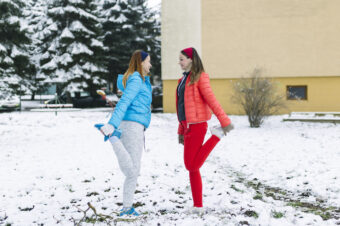

How Heat And Cold Therapy Promotes Muscle Recovery For Athletes
BlogHealth & FitnessNewsNewsTickerProduct Reviews/Top Ten Lists/Resources/TipsStaffPicks December 4, 2024 Lauren Keating 0

Athletes know that recovery is just as important to training as the workouts. After constantly pushing their bodies to the limit, it’s essential to find and use effective recovery strategies that promote peak performance and avoid injury. Among the most widely used recovery methods are heat and cold therapy.
Scientifically supported for aiding in easing muscle fatigue and boosting repair, heat and cold therapy help reduce inflammation.
What is heat and cold therapy?
Cold therapy treatment includes using ice baths, cold compresses, cryotherapy, or submerging the body in an ice bath.
According to orthopedic surgeon Dr. Myroslav Dosiak, cold therapy works by using the temperature to narrow blood vessels. This then reduces blood flow to the affected area, decreasing swelling and numbing pain.
“Cold therapy temporarily reduces circulation to limit swelling and inflammation,” Dr. Dosiak said. “It is effective in decreasing inflammatory responses after intense exercise or trauma, and helps reduce muscle soreness and accelerates recovery.”
On the contrary, heat therapy increases blood flow by widening the blood vessels. The heat “relaxes muscles, reduces stiffness, and improves flexibility.”
With enhanced circulation, heat therapy helps to deliver more oxygen and nutrients to the muscles. Dr. Dosiak added that heat therapy also relieves muscle tension and can help with chronic injuries.
Athletes experiencing chronic lower back pain, tight hamstrings, or shoulder stiffness often find relief with heat therapy.
Examples of heat therapy include heating pads, warm towels, or hot baths.
“Heat therapy should be avoided immediately after acute injuries due to potential increase in inflammation,” he said.
When To Use Cold vs Heat Therapy
Dr. Dosiak said cold therapy should be used immediately after acute injuries, intense workouts, or when inflammation is present. It’s best for treating acute injuries such as sprains, strains, or bruises, as well as for post-exercise muscle soreness (DOMS). “A sprinter applying ice packs to hamstrings after a race to minimize swelling,” is the example he used.
His examples of effective cold therapy include “ice packs applied to injured areas to reduce swelling, cold water immersion or ice baths post-exercise, or whole-body cryotherapy sessions for systemic inflammation reduction.”
Cold therapy should last 10 to 20 minutes per session, and repeat every one to two hours during the first 24-48 hours after an injury. “Use a cloth barrier between ice and skin to prevent frostbite,” he added as a precaution.
Heat therapy should be used for chronic muscle pain, and stiffness, or as a pre-exercise warm-up. It is most effective for treating chronic conditions like arthritis or long-standing muscle tightness. “A golfer with chronic shoulder stiffness using heat therapy before playing,” Dr. Dosiak said.
His examples include “heating pads applied to tight muscles before activity, warm baths or showers to relax the entire body, and infrared saunas or lamps for deeper tissue relief.”
Heat therapy should last between 15 and 20 minutes per session and be repeated daily as needed. “Ensure the heat source is warm, not hot, to prevent burns,” Dr. Dosiak said.
Alternating Therapies
There are benefits to using both cold and heat. This includes stimulating circulation more effectively and reducing muscle spasms and inflammation. To do so, he instructs athletes to alternate between heat (three to five minutes) and cold (one to two minutes), and repeat this for a total of 20 to 30 minutes.
“Athletes can benefit from contrast therapy, especially during intense training periods, but should tailor their approach based on individual responses,” he said.
The best cold therapy is whole-body cryotherapy. These are quick two to three-minute sessions that provide immediate relief and may even boost the immune system. This is a great solution for athletes who dislike traditional ice baths.
Infrared heat therapy provides deeper penetration into the muscle tissues and doesn’t overheat the skin. Try an infrared sauna or portable device for this enhanced recovery method.

Photo: Freepik
More Tips
Dr. Dosiak recommends applying heat before stretching to allow for a deeper stretch. “Heat before massage enhances muscle relaxation, improving effectiveness.”
Combining cold therapy with compression socks or sleeves reduces swelling more effectively. “Cold compression devices provide simultaneous cooling and pressure,” he added.
Other tips include staying hydrated and focusing on nutrition for recovery. Get enough sleep and establish a consistent recovery routine to enhance mental readiness and reduce stress.









No comments so far.
Be first to leave comment below.